Texture rich, flavorful and tender, homemade Seeded Multigrain Gluten Free Sourdough Bread is gluten free bread you’ll look forward to eating. Use your Gluten Free Sourdough Starter to make this whole grain gluten free bread and love bread again! This recipe is gluten free and vegetarian or vegan.
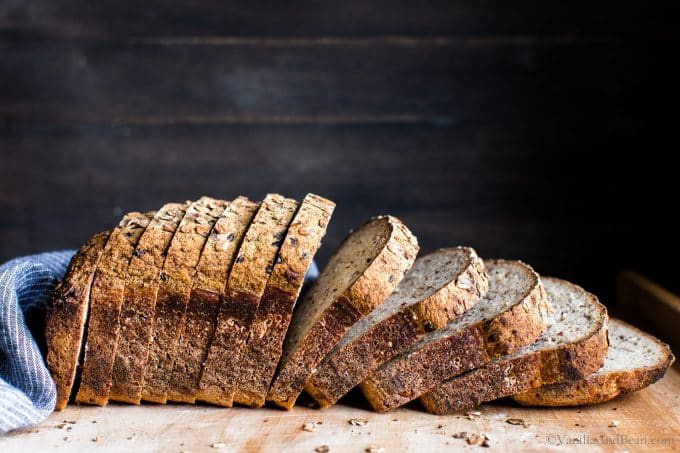
Table of Contents
Going Gluten Free
Going gluten free for a trial period in the summer of 2018 meant I had to give up my beloved homemade sourdough. After a few weeks of throwing internal fits, I finally decided to explore gluten free flours, and learn the nuances of gluten free baking. I knew it wouldn’t be easy, but I finally embraced the challenge.
After much research, creating a gluten free sourdough starter and baking many loaves of gluten free sourdough bread, testing, tweaking and taking notes along the way, I’m sharing my best loaf yet: Seeded Multigrain Gluten Free Sourdough Bread.
Although I’m eating gluten again, this bread remains one of my most beloved recipes on the blog. I hope you enjoy it as much as my family, friends and V&B makers have.
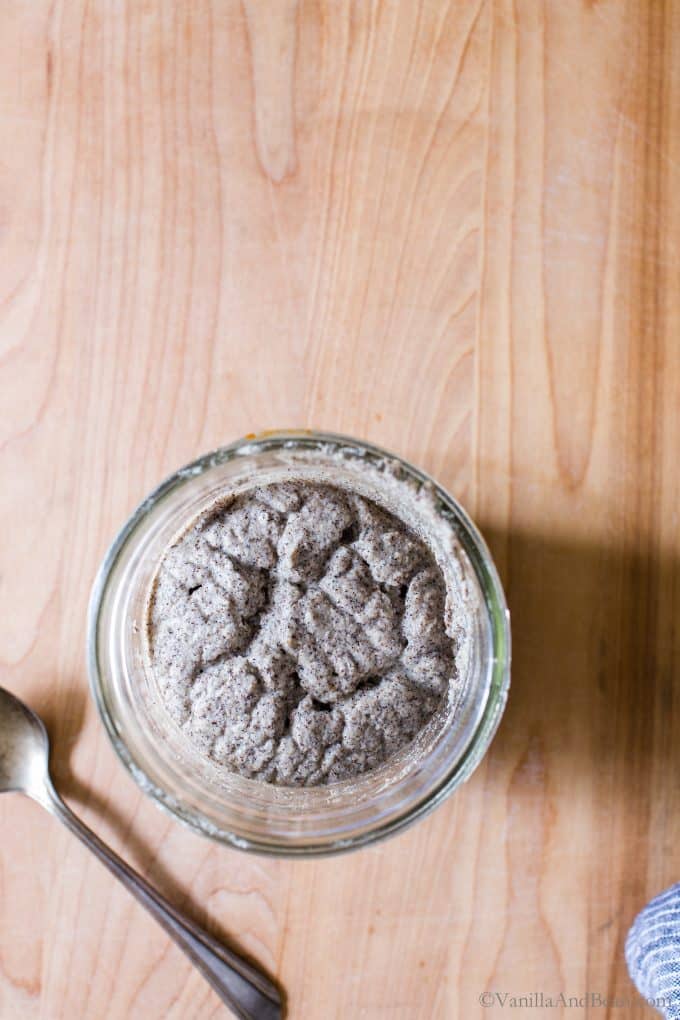
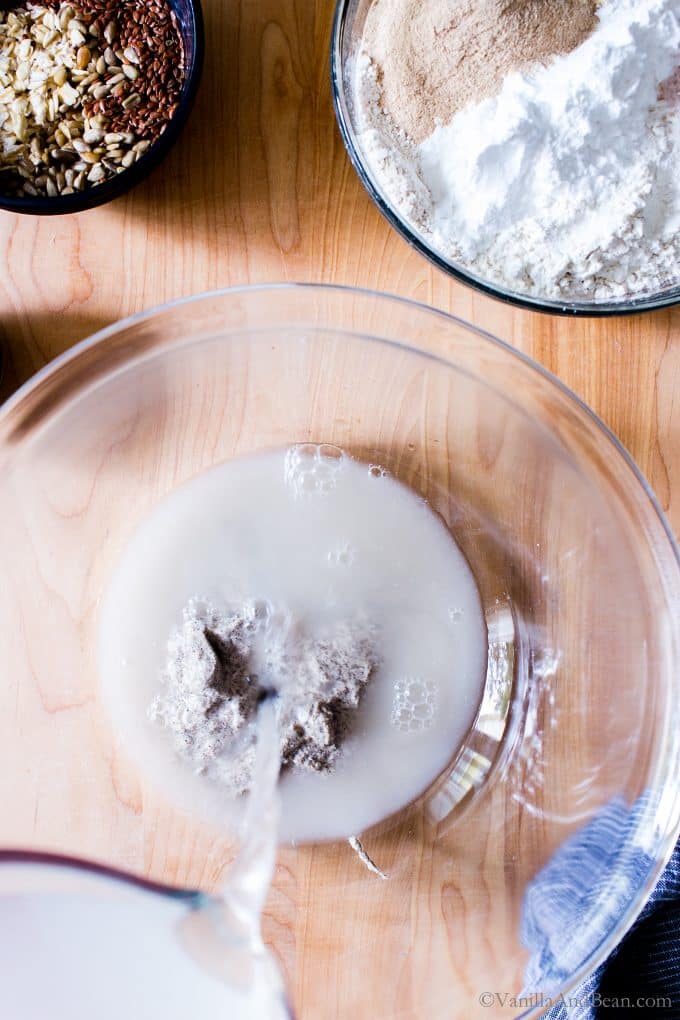
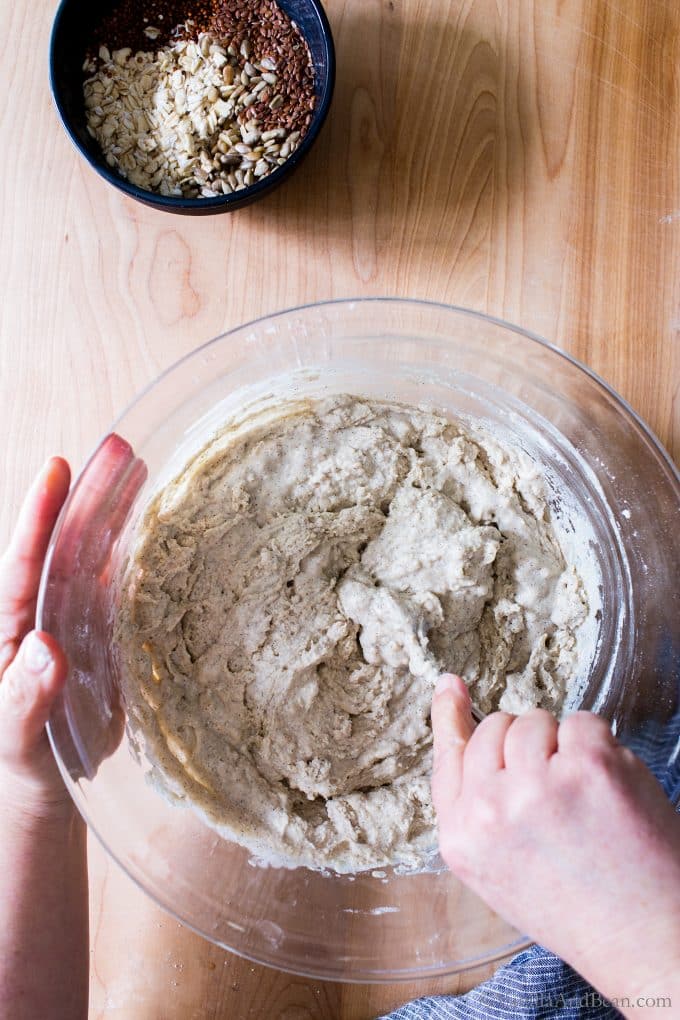
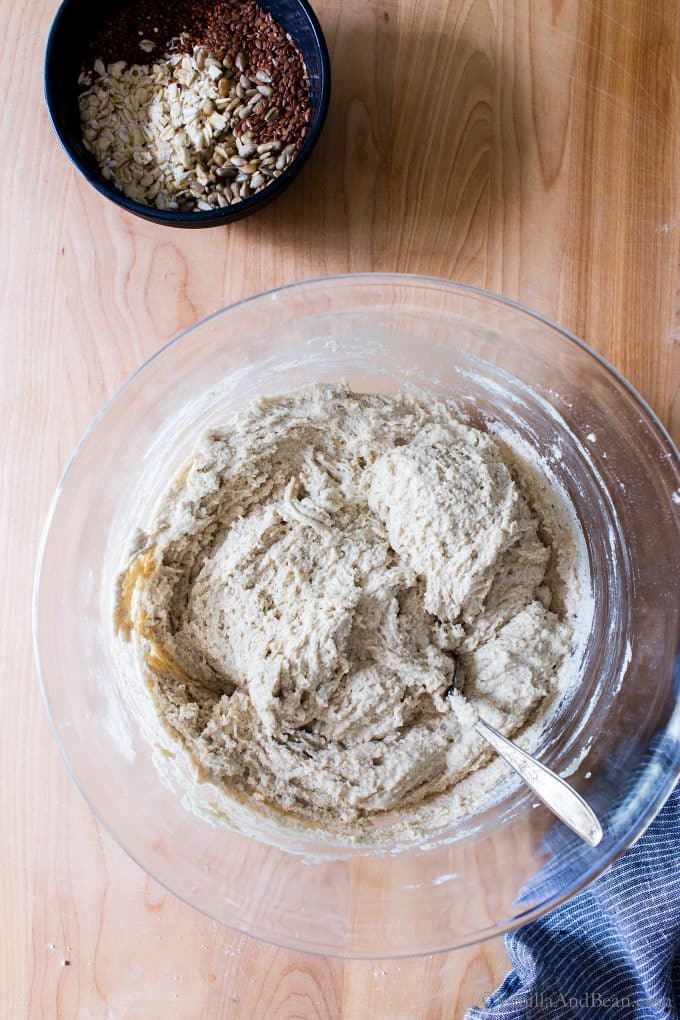
How to Make Multigrain Gluten Free Sourdough Bread
This gluten free sourdough bread recipe is simple to make, but you’ll need a gluten free sourdough starter. My starter recipe takes six to seven days to develop, but once you create it and continue to refresh (feed) it, it’ll be on stand-by next time you’re ready to bake! In summary, here’s how to make this GF sourdough bread (see recipe card for details):
- First, prepare the soaker by placing the flax, oats, quinoa, and sunflower seeds into a small bowl. Pour room temperature water over the top of the soaker. Allow to sit overnight (or see shortcut in recipe).
- Second, in a medium bowl, whisk the flours including oat, brown rice, millet, tapioca with psyllium husk powder and salt.
- Third, in a large bowl, whisk your fed starter, water, and maple syrup or honey. Add the flour mixture to the starter/water mixture and mix with a fork.
- Fourth, hand mix in the soaker.
- Fifth, transfer the gf sourdough to a prepared loaf pan, while patting and smoothing the top and rounding the edges of the dough.
- Next, cover with a damp tea towel and ferment for 12-14 hours at room temperature.
- Last, bake the loaf for about an hour.
You’ll notice there is no proof for this recipe, meaning it only rises once (fermentation). Once the loaf is shaped and undergoes bulk fermentation, it’s ready to bake.
After baking, the gluten free sourdough needs to cool completely, at least a few hours before you slice into it! Waiting until the following day is even better as it allows the bread time to cure.
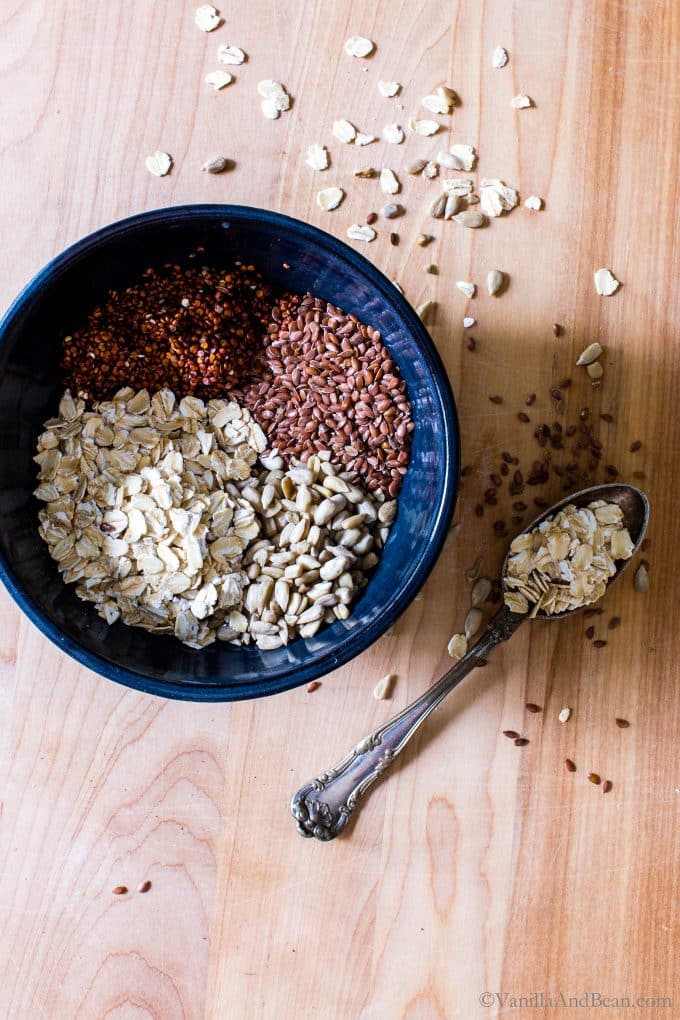
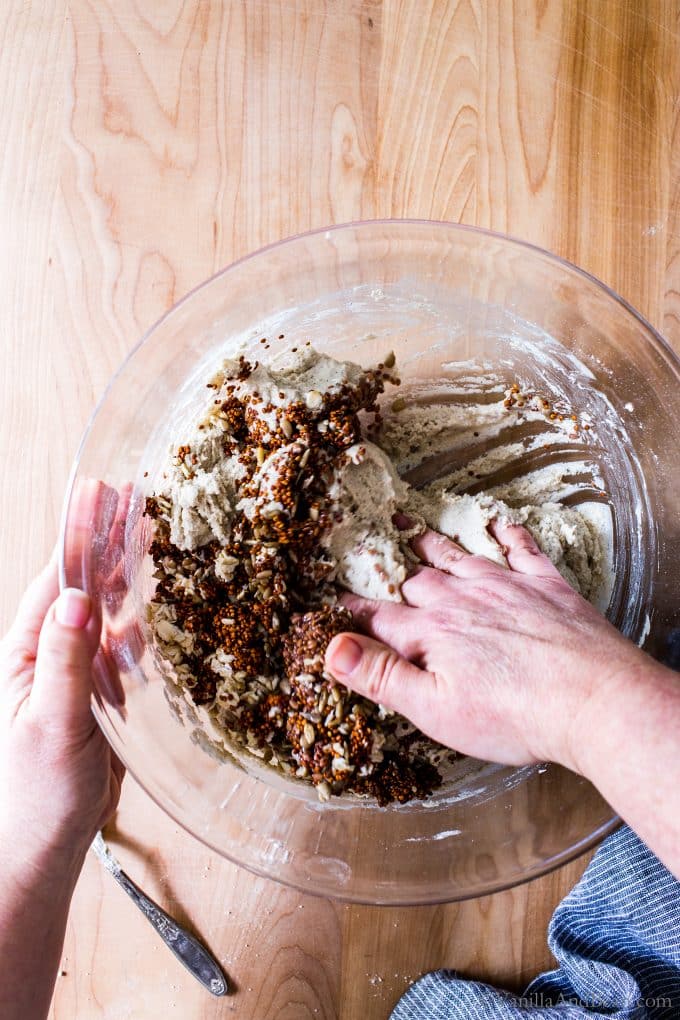
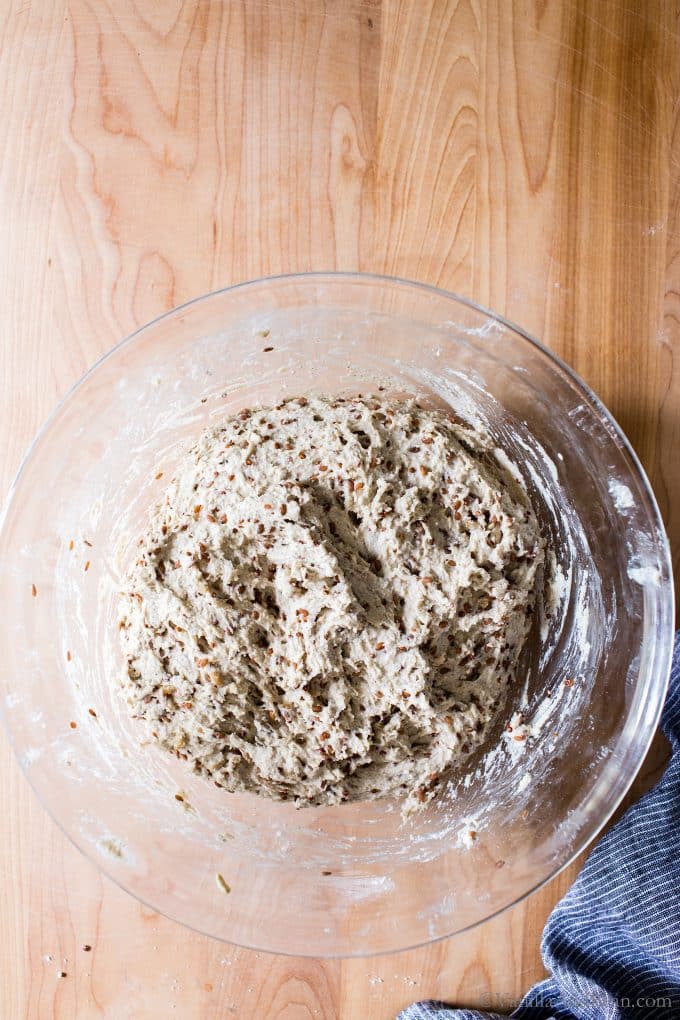
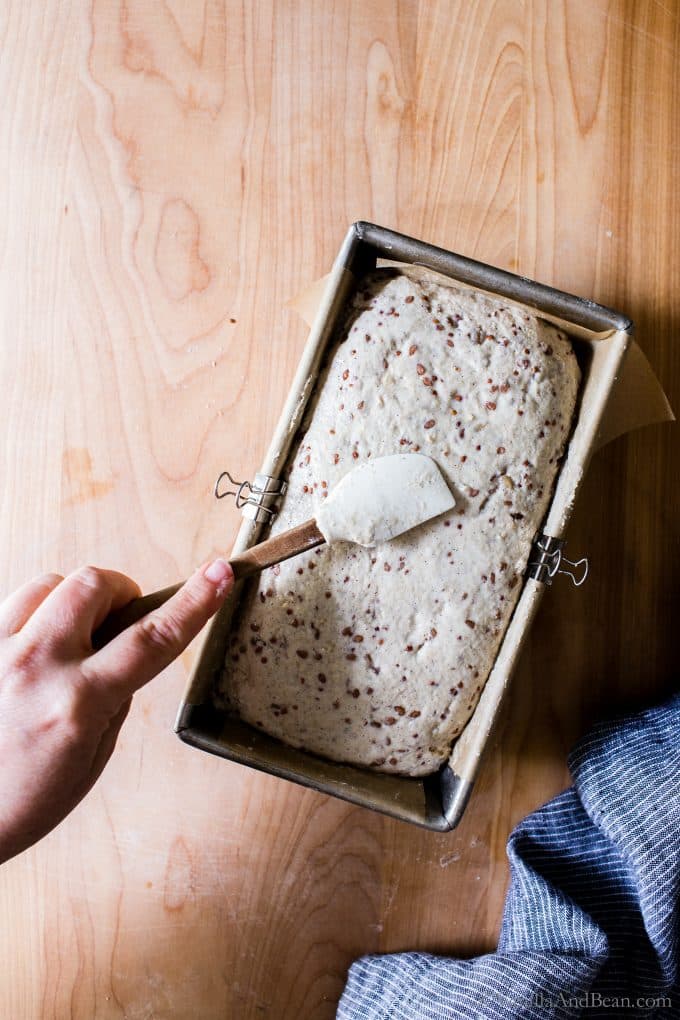
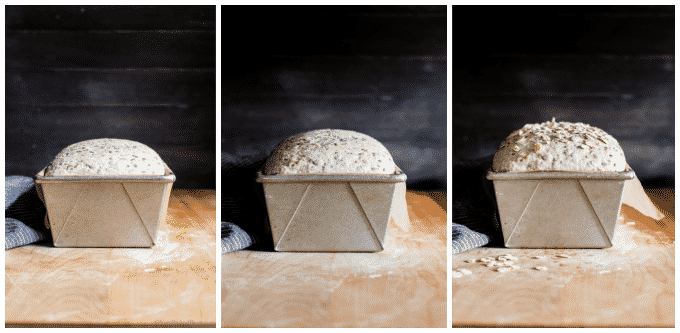
Can I Use Other Gluten Free Flours in this Recipe?
You can certainly give it a go! I’ve tried subbing buckwheat and amaranth flour for millet in this recipe but the bread wasn’t as tender and light. I’ve found thorough trial and error that millet helps give loft to gluten free bread without adding more starch. Also, amaranth was a little too strong for my taste.
What Does this Gluten Free Sourdough Bread Taste Like?
In a word, earthy in such a good way! This gf sourdough bread is texture rich due to the seeds/grains, has a mild oaty flavor, and a chewy interior thanks in part to the binding power of psyllium husk powder, with a nice crisp crust (after toasting).
Because this bread is gluten free, egg and dairy free (yes, vegan gluten free sourdough bread!), mostly whole grain, free of fillers and large quantities of starches, you’ll notice the interior is moist/tacky to the touch. So, it needs to be toasted to bring out its best texture. Sometimes I’ll double toast for breakfast toast, aka, avocado with egg toast.
How Do I Store Gluten Free Sourdough Bread?
After the bread is completely cool, slice it with a serrated knife. The slices can be stored at room temperature in a closed container for up to three days or frozen for longer storage. For freezer storage, slices can go from freezer to toaster directly – this is also when I’ll double toast a slice.
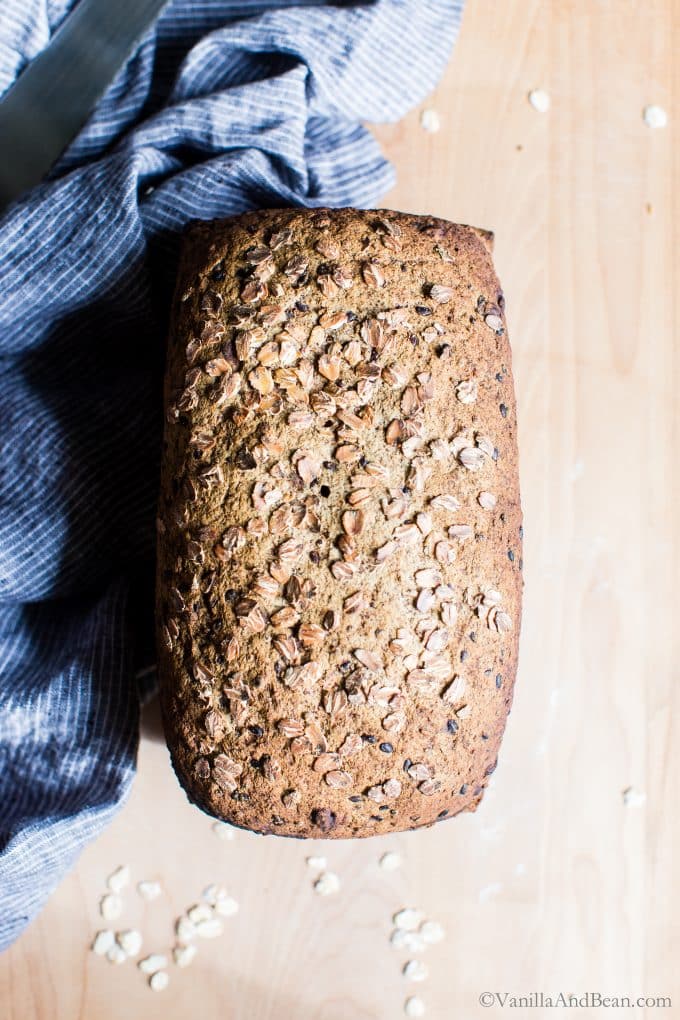
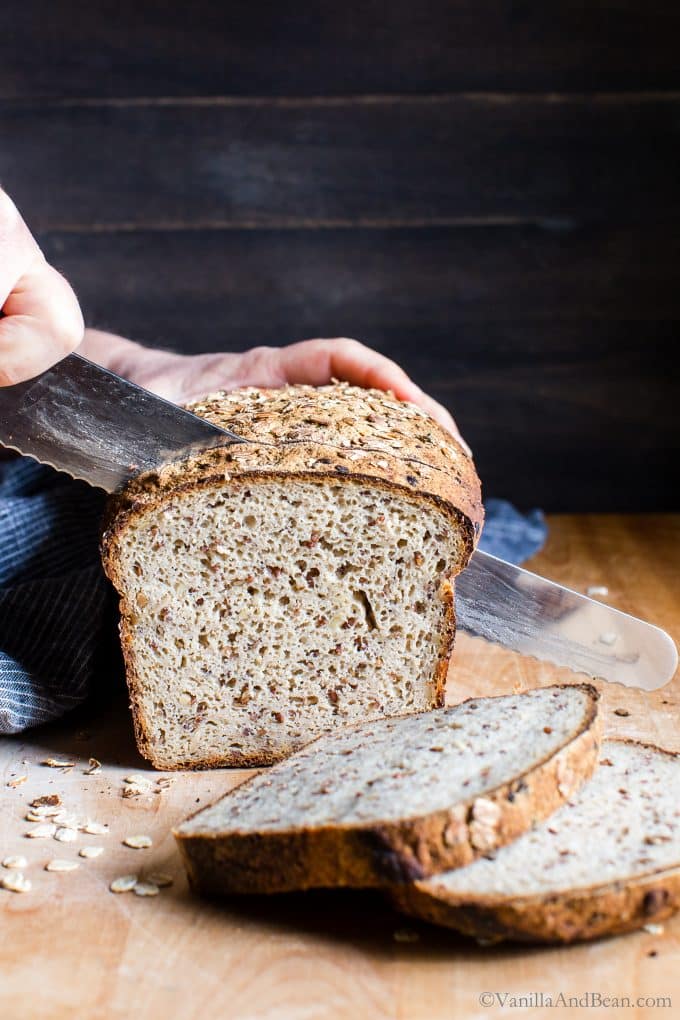
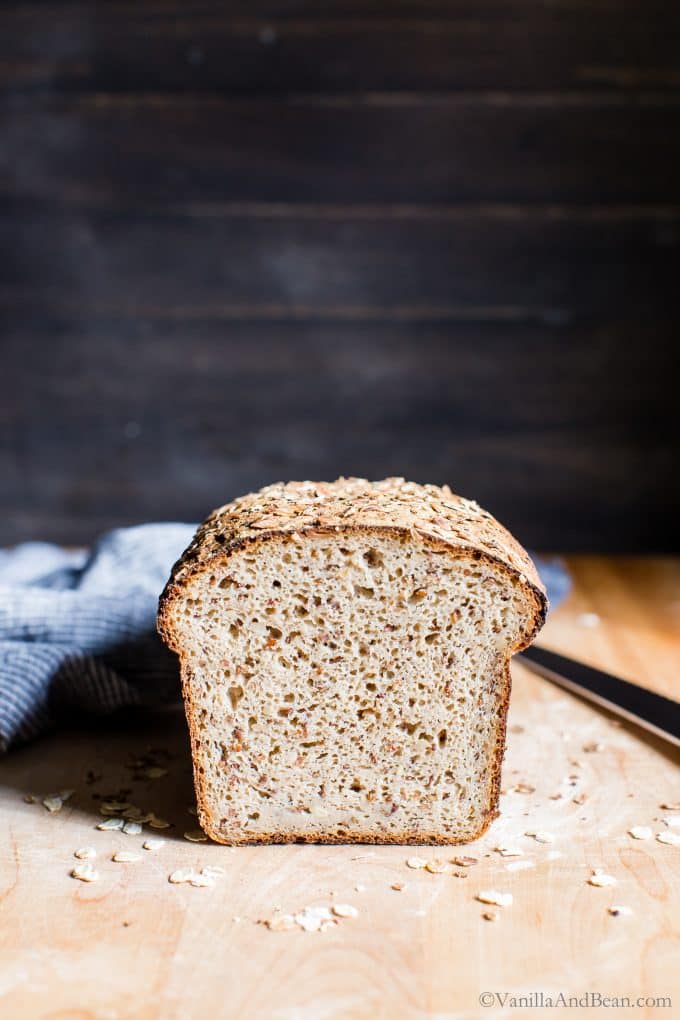
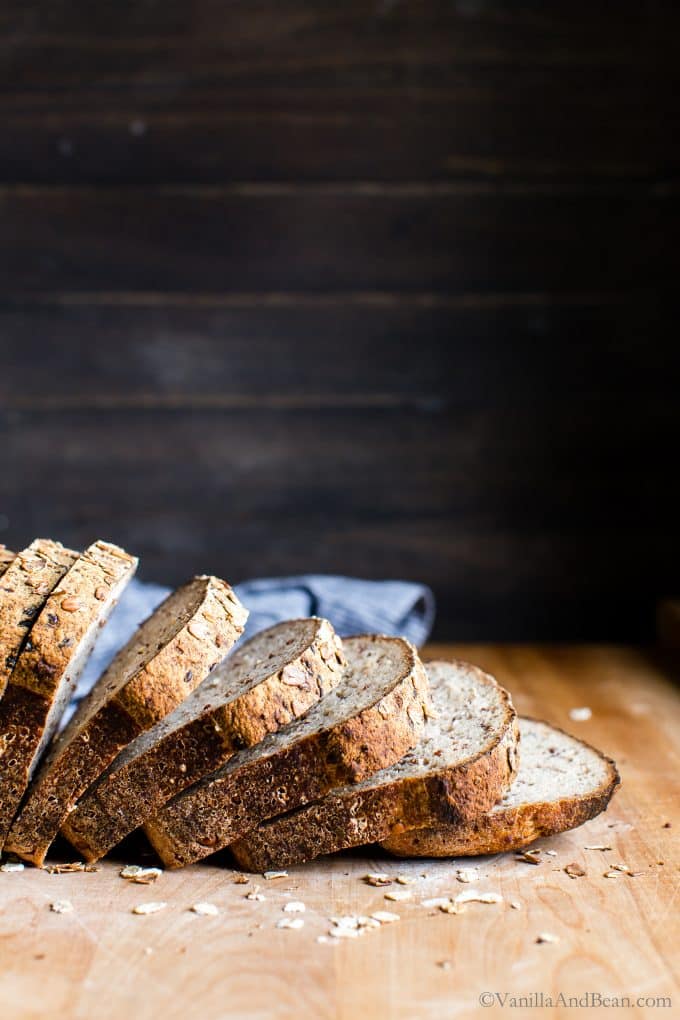
A Few Recipe Notes
- Sourdough discard? Save it, put it in a covered container in the refrigerator and then, make these Gluten Free Sourdough Pancakes, Gluten Free Sourdough Waffles, or Gluten Free Sourdough Pizza!
- Dutch oven? I’ve tried this recipe in a Dutch oven in an effort to make a boule. Without walls of a loaf pan to hold the dough together, it spread way too much and was flat. Stick to a loaf pan ( if not experimenting :D ) .
- Shaping and then transferring the dough to the pan is sticky business. I’ve included two ways in the recipe to get the hardest part of the recipe done: a. shaping prior to putting the dough into the pan or b. shaping the dough after putting it in the pan. I prefer method a. as it produces a better shaped loaf – but it’s harder to do. Note the photos show method b.
- With a 119% hydration, this dough is sticky. But I’ve found gluten free loaves with higher hydration and low starch content have a better rise and produce a more tender crumb.
- One of the flours used in this recipe is oat flour. I DIY oat flour and have a tutorial on the blog if needed.
- Substitutions: I do not recommend subbing any other ingredient for psyllium husk powder. It soaks up the water, gives the bread it’s chew like gluten-full bread has and holds the dough together.
- I’ve tried subbing buckwheat and amaranth flour for millet in this recipe but the bread wasn’t as tender and light. I’ve found millet helps give loft to bread without adding more starch. Also, amaranth was a little too strong for my taste.
- I’ve not attempted subbing a different flour for oat flour.
- Use a scale. In baking, weighing ingredients is important for optimal outcome. I find that especially true in gluten free baking. I recommend investing in a good digital kitchen scale.
More Gluten Free Sourdough Recipes to Love
Makers Notes
So happy to read y’all are enjoying the bread in the comments below. Please note, I’ve not tried the following substitutions, but want to share what the community has offered. Here are a few community notes that may be helpful when making this recipe:
- Maya commented: “I used sorghum flour for the oats and half buckwheat, half white rice for the millet. It might not have risen as much as your photo, but it still turned out great.”
- Kate said: “It worked great – I substituted the same amount of arrowroot powder for the tapioca flour.”
- Sarah said: “Slice thick and when toasted you get the crusty edges and soft spongy center.”
- Jill said: “…substituted the brown rice, millet, and tapioca for an even exchange of the King Arthur cup for cup gluten free. This loaf came out SOOOOO GOOD!”
- Leah said: “…sorghum for the oat flour and teff for the millet. I got a nice rise and it came out SO good! The teff really gives it a wheaty flavor, almost like pumpernickel. Both times I left out the soaker and it didn’t seem to be a problem.”
Seeded Multigrain Gluten-Free Sourdough Bread Recipe
Ingredients
For the Soaker:
- 3 Tbs Whole Flax Seeds
- 3 Tbs Whole Rolled Oats gluten free
- 3 Tbs Red or Tricolor Quinoa rinsed under running water
- 3 Tbs Hulled Sunflower Seeds
- 1/3 C (80g) Water room temperature
For the Bread:
- 1/3 C + 2 Tbs (100g) Gluten Free Sourdough Starter previously fed, and doubled in size
- 2 1/2 C + 2 Tbs (605g) Water 80F (27C)
- 3 Tbs Maple Syrup or Honey
- 1 C (145g) Brown Rice Flour
- 1 C (150g) Millet Flour
- 1 1/4 C (130g) Oat Flour gluten free
- 1/2 C + 1 Tbs (80g) Tapioca Flour
- 3 Tbs Psyllium Husk Powder **See note on brands
- 3 1/2 tsp Fine Sea Salt or reduce to preference *See note on salt adjustment
- 1-2 Tbs Whole Rolled Oats for sprinkling on top, gluten free
Instructions
For the Soaker:
- Prepare the soaker by placing the flax, oats, quinoa, and sunflower seeds into a small bowl. Pour room temperature water over the top of the soaker. Leave out at room temperature for about 6-8 hours. If you forget to do this, you can pour hot water (hot to touch) over the soaker before you start preparing the ingredients for the bread.
For the Dough:
- Line the inside of a 8.5L x 4.5W x 2.75H inch loaf pan (23cm X 13cm) with criss crossing parchment with enough hangover on all sides to later help shape the dough and to be used as handles for removing the bread from the pan. If you have clips to clip the parchment to the sides, use them.
- UPDATE 5/20: Some makers have commented that they "poured" the dough into the baking pan. Please note that the dough should be of a sticky thickish batter-like consistency where it is scraped into the pan and holds together. The dough should not be pourable. In order to achieve this batter-like consistency, Psyllium Husk Powder is essential. I do not recommend substituting this ingredient. *If still concerned about a pourable batter, hold a little bit of the water out instead of adding it all at once, then add more as needed. Mix the Dough: In a large mixing bowl, add the starter, water and maple syrup (or honey). Whisk until the starter is incorporated. Set aside.In a medium mixing bowl whisk the brown rice flour, millet flour, oat flour, tapioca flour, psyllium husk powder and fine sea salt. Mix throughly so that when the psyllium husk powder hits the water, it wont clump. To the water/starter mixture add the flour mixture. Use a fork to mix the flour into the water until the dough starts to stiffen, about one minute. The dough will feel like a thick batter. Add the soaker and knead the dough with your hand, incorporating the soaker until the mixture is evenly distributed, about one minute. Use the fork to scrape any excess dough off your hands and fingers. The dough will be very sticky. Set the bowl aside for about 10 minutes to rest. It will stiffen a bit as it rests.
- Shape and Pan the Dough: There are two ways to approach shaping. a. if you're in a hurry or b. if you have a bit more time and patience. Either will work but I find I get a better shape out of b. (note that a. was used in the images seen above). A. Scrape the batter into the loaf pan. Use a moist rubber spatula (remoisten as needed) to gently shape the top nudging the edges of the loaf inward to produce a nice dome shape loaf bread is known for. This takes a little practice and finessing. Just do the best you can. Use the 'handles' of the parchment and pull opposite sides inwards towards the center of the dough, helping to round and shape the edges. Moisten your fingers or small spatula and smooth the top to rid any lumpy areas. B. A bench scraper for this method is needed. Moisten your work surface with a bit of water (I use a spray bottle and sprits it a few times). With moistened fingers, nudge the dough out of the bowl and onto the moist surface. The dough will be very sticky. Re-moisten your hands and pat the dough into a rough rectangle/log a little smaller than the size of the loaf pan using the bench scraper as needed to move the dough. Pat and smooth the edges as needed using wet hands (no flour here), rocking the dough back and fourth to help shape it, smoothing and rounding the top into a rectangular dome. This takes a little practice and finessing, just do the best you can. Using one swift move, scoop up the shaped dough with a bench scraper and transfer it to the loaf pan. Use the 'handles' of the parchment and pull opposite sides inwards towards the center of the dough, helping to round and shape the edges. Do this several times. Moisten your fingers or small spatula and smooth the top to rid any lumpy areas. Use a moist rubber spatula to gently shape the top nudging the edges of the loaf inward to produce a nice dome shape loaves of bread are known for.Now is a good time to refresh (feed) your starter and store it for next time.
- Bulk Ferment: Remove the clips from the pan if using. Cover the dough with a wet tea towel and allow the dough to ferment overnight at room temperature (it's okay if the wet tea towel touches the top of the loaf). Fermentation will take anywhere between 12-14 hours depending on how active your starter is and ambient temperature. In my chilly kitchen at 66F, the dough takes about 14 1/2 hours to rise overnight. There is no proof for this recipe. Go right into baking the loaf after bulk fermentation. The loaf is ready to bake when the dough increases to 1 1/2 times in size and has risen to about 1.1/2" (3.8cm) above the lip of the pan at the center. The dough will spring back when gently pressed on top.
- Bake the Loaf: Place a oven rack in the center of the oven and preheat the oven to 550F (288C). Lightly spray or brush the top of the dough with water and sprinkle 1-2 Tbs of rolled oats over the top. Decrease the oven temperature to 475F (246C) and bake the loaf 55-60 minutes or until the internal temperature of the bread is between 200F-205F. If the bread starts getting too dark on top, tent the bread with foil. The bread pictured here is untented. After 10 minutes out of the oven, transfer the bread to a cooling rack. Cool completely, at least for two-three hours, better if cured overnight, before slicing into it. You'll notice the bread is very hard, but will soften as it cools.
- How to Store and Enjoy!: After the bread is completely cool, slice it with a serrated knife. The slices can be stored at room temperature in a closed container for up to three days or frozen for longer storage. For freezer storage, slices can go from freezer to toaster directly.You'll notice the interior of the bread to be tacky. This is normal. I find this gluten free sourdough needs to be toasted before it's enjoyed... sometimes double toasted to bring out its best flavor and texture.






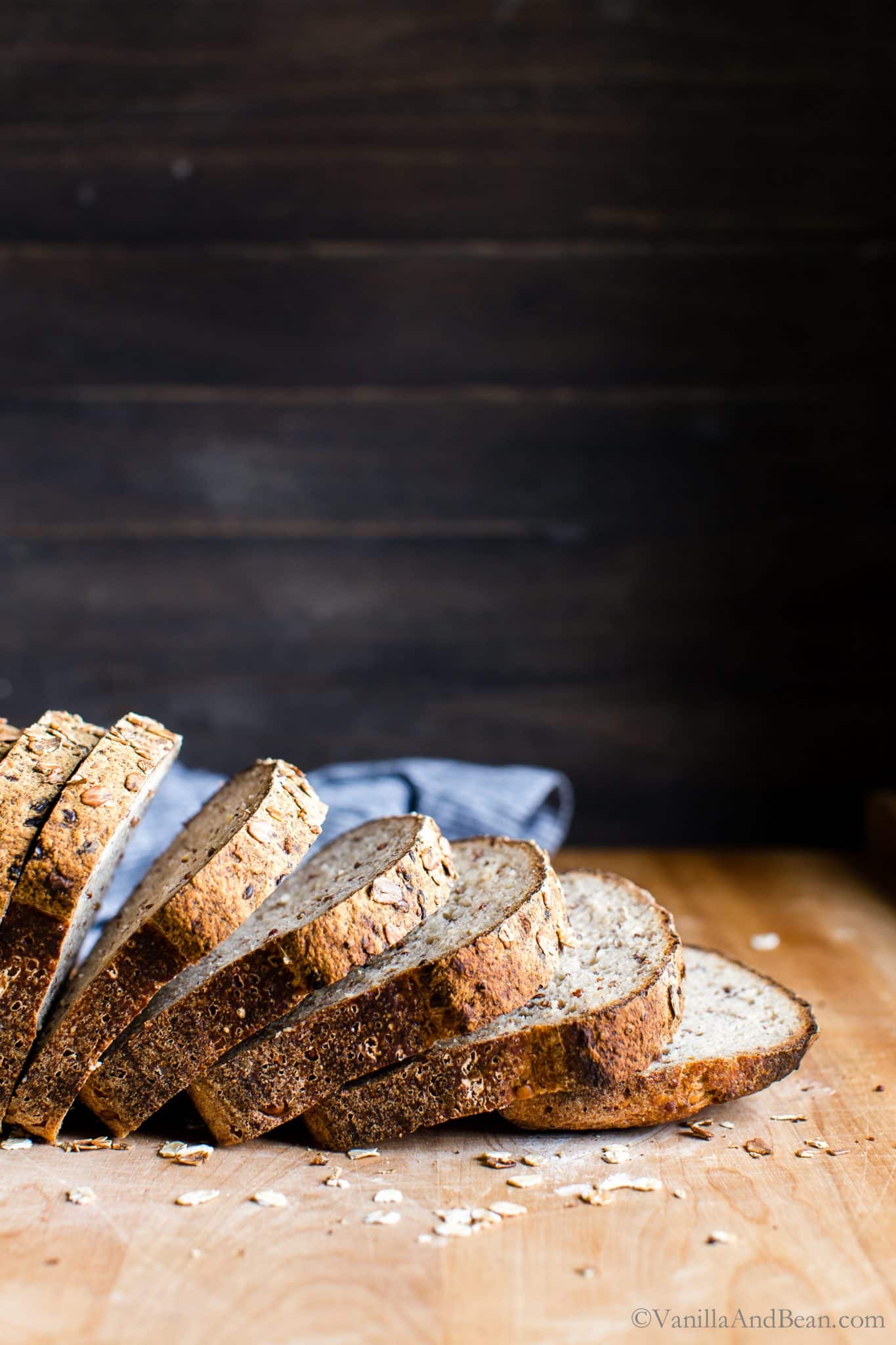
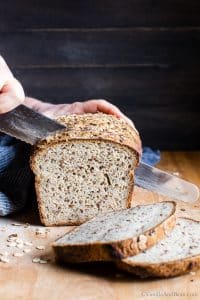
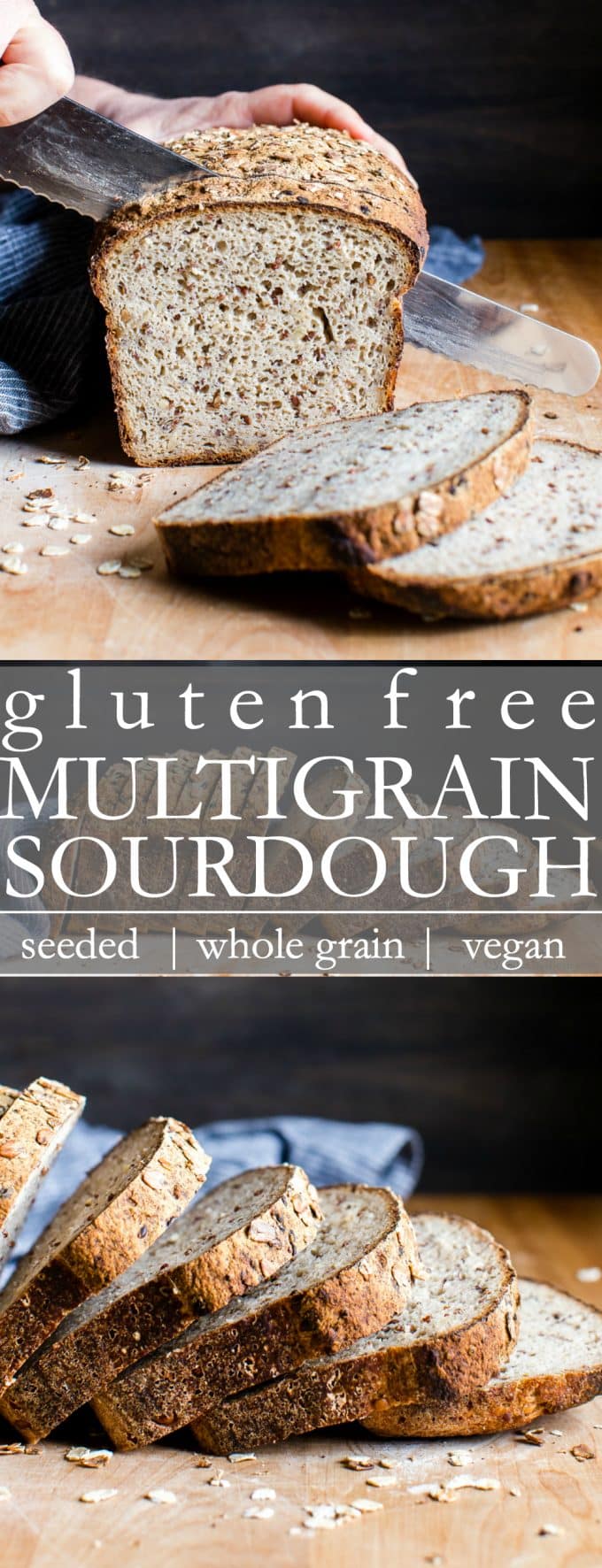
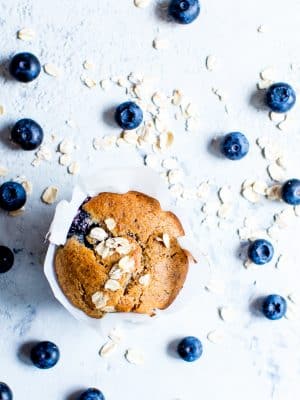

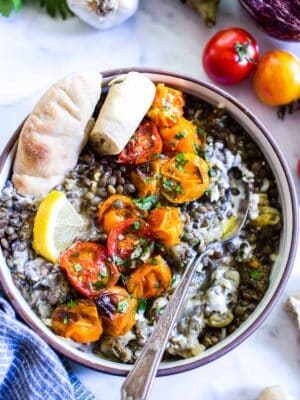
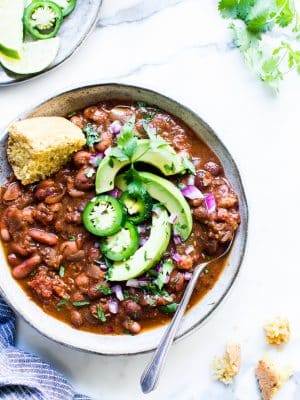



I followed this recipe to a T and the bread was extremely salty that I had to throw the whole loaf away.
Hi Cebrina, I’m sorry to hear this. However, there’s a note on the recipe card regarding salt, to reduce it if you prefer less salt.
Just completed my first bake of this recipe, for the first attempt using a small toaster oven the bread turned out very nice.
Here are some of my details and what I did.
Location – SE Asia in hot and humid environment.
Oven – Very small toaster oven with strategically placed tin foil (none touching the loaf).
Starter – Brown rice starter about 3 weeks old (pretty young).
Ferment period – 6 hrs at room temp. (Approx 30C/86F) & 6 hrs in the fridge. I fed my starter at the wrong time of day so my loaf was ready to bake VERY early in the morning. I didn’t want it to over proof so I got up and baked it. 😁
Amendments I followed as suggested in the recipe.
– I used only 550g water and the dough was a great texture.
– I used only 3 tsp salt which seems to be a good level for our taste.
I will make this recipe again for sure. my wife and I each had a piece with breakfast, it was delicious, we couldn’t wait for it to sit more than 4 hrs.
Update – Just had a slice of this toasted with butter. 🤯 Amazing!!
Best news ever, Brent! SO happy to hear. Thank you for letting us know!
Is the sweetener required?
Hi Melanie! You can leave it out. However, it’s there to balance the whole wheat and nutty flavors. I hope you enjoy the sourdough!
Can this be made with instant yeast? Thanks!
I was looking for a multigrain sourdough bread recipe and found a great one in this recipe. It’s easy to make and is very delicious.
My daughter was pregnant and had terrible nausea! Thus bread us “her friendly” as in her food allergies and she could enjoy it and keep it down. I made two loaves at a time and shipped them to her! Thank you so much for thus wonderful forgiving recipe. Ih. And I add caraway seeds to the soak. Yum.
It is totally my fault that I wound up with a pourable batter! I used psyllium husk, not psyllium powder. You made it very clear (I don’t even think a flashing red warning would have helped me!) I just wasn’t paying attention. I added enough buckwheat flour to get it to the consistency I thought it should be. It came out awesome! No gumminess at all and very tasty! Now I’m not so sure I want to try it the correct way!
Hi Dina! Oh, I’m so glad it came out!! We all learned something here, so I appreciate your note and letting us know. Hooray for a tasty loaf of GF sourdough!
My bread sunk while baking.
My kitchen is around 30c so I made it the same day and baked it within 5 hours. My rise was around 2” high and I used half the recipe.
I used a combination of pearl millet finger millet and sorghum where you mentioned millet flour. Did I make a mistake?
Hi there Simran! Oh no! At half the recipe, 2″ high with sinking sounds like it over-proofed. I’m afraid I’m not familar wtih pearl and finger millet, so I’m not sure how that could have impacted the outcome.
Wondering if the bread can be made without the soaker. We have multiple allergies in our family, nuts, pea, soy, dairy, seeds and a celiac avoidance. So hard to find or make a loaf if bread that fits us all
Hi Stacy! Makers have made this recipe without the soaker and report delicious results (see comments below and notes above the recipe card). I hope this helps! Please let us know how it goes 🙋🏻♀️
Thank you SO much! I will try and let you know!
Hi Traci, I’ve been making this bread for quite a while. It is the best. I wanted to share some variations/changes I have made. I use teff flour in the starter instead of the sweet rice flour as I find it gives a better rise in my kitchen. I also don’t need to line the pan but simply oil it. I’ve had fun with the soaker, and vary the seeds. Every one who has had it agrees it is delicious, whether they are GF or not. Thanks for developing and posting this recipe,
Made this last night in a round cake tin that releases. It turned out delicious! I forgot to soak the seeds, etc. so poured the water on and then steamed them in a bowl in the steamer as they still seemed too firm. Wondering if the long wait is to sprout or semi-sprout them? Anyhow it was nice tasting…probably the best so far as for being not too sour. I’ve had my sourdough going for over 2 years. This is a keeper. Bought a loaf tin today to try for a higher loaf with the next bake. Thanks for your post! Will look for more from your site.
I love this bread! I have been making sourdough for 3 years and this is my first GF bread! I am already planning Christmas gift breads.
Amazing ! A friend introduced me to gluten free soughdough starter, I’ve only just started making GF sourdough bread recent weeks. The minute I found this recipe, I couldn’t wait to try….then I made it, thanks for the detail instructions and the extra notes, I reduced the psyllium husk to 2 and a half tablespoon, with less salt, BRAVO….it turned out so good, it rise just like your photo. I love it, share it with my friends and family. I will definitely make it again! Next time, I’ll experiment with walnut & cranberry to see if it’s as good.
SO excited Jenny! Thank you for your note, review and sending a smile! SO happy to read your results. Walnut and cranberry sounds delish!
Hi Tracy,
I made the bread yesterday in my new breadmaker. It tastes sooo good but it is a bit sticky inside. Maybe because the breadmaker does not bake so high? Otherwise I’m very happy with it. When first tasting the crust, and yes I could not wait until it was totally cold, the ground millet was a bit crunchy, but inside the bread it’s totally fine.
Thank you for a very tasty and healthy Gluten-free recipe.
Hi Evie! Thank you for your note and giving the GF SD Bread a go! SO excited you enjoyed the bread. I’ve no experience with a breadmaker (is it a small electric or Dutch oven?), so I’m unable to say how it would effect the outcome of this bread. However, I did find through my testing that a high temperature is essential. This bread is a bit sticky inside even when following the baking temperature, and so, slices do benefit from toasting. Also, cooling the bread completely before slicing it helps develop texture and crumb.
Thank you Traci for your reply.
I actually bought a Panasonic electric breadmaker and baked the bread in there. I guess the temperature is not high enough.
I will try again in a dutch oven in my conventional oven with high temperatures.
Hi Tracy, Your bread recipe is everything you promised. It is light and moist and toasts nicely. My reason for giving only 2 stars is a bit unusual. I have just started using a continuous glucose monitor to see the effects of various foods on glucose spikes. I am afraid this bread gave me the biggest spike so far after 10 days of monitoring. I suspect the rice flour, tapioca flour and oat flour all contributed to this. I may try it again with higher protein and fibre flours like quinoa and buckwheat. I would caution people with diabetes or pre-diabetes and also anyone concerned (like me) with glucose spikes to be aware of this issue.
Thank you so much for your wonderful recipe. It is my favorite gluten free bread recipe. I’ve also found that by adding 1/2 tsp. of active dry yeast to the water and honey, the rise time is of course reduced and the dough can be formed into 12 bagels that rise within 40-50 minutes. They stand up to careful boiling and then baking at 425 degrees for 20 minutes. By varying soaker seed types, your recipe makes delicious cinnamon raisin or everything bagels. Again thank you for sharing.
How wonderful, Joanne! Thank you for sharing your tips and bagel recipe with us. I can imagine how chewy and flavorful they are.. and cinnamon raisin is my favorite of all. Makers have been telling me how versatile this recipe is, but bagels are over the top!
This recipe is a gem! Perfect level of detail in the instructions so that I could bake it with confidence. I even ground most of the flours from their grains in an electric spice grinder to save money, but thanks to the long rise time it wasn’t the least bit gritty. My husband who has been baking sourdough bread for years is very impressed with this recipe. I’m hooked!
Hi Liz! Thank you for your note, review and giving the sourdough a go. So happy you and your husband are enjoying the bread, and that a sourdough baker sends his complements! :D
Hi there is can I sub oat flour for another gluten free flour as I can’t have oats
Hi Ann-Marie! Take a look at the “maker’s notes” section above the recipe card for substitutes. While I’ve not tried any of these, the community has had good results in making substitutions. There are also more recommendations in the comment section if you’d like to take a look there too. If you give the sourdough a go, let us know how it turns out! Have fun!
Hey there! So I used used my regular strong levain to begin my GF starter. I used it as my base, and then started adding GF flour for feeding. This means my GF starter is really strong, and my bread is rising pretty quickly. Can I ferment this overnight in the fridge like I do regular sourdough to slow it down but still develop the flavor? Otherwise I think it will overproof…Thanks!
Hooray for a strong levain, Tracy! You can do the bulk ferment overnight in the fridge. Just make sure to put two moist tea towels over the top so it doesn’t dry out and allow it to double in size before you shape it. I’ve not tried proofing this dough in the fridge, but I worry if your starter is really strong, it may overproof. I hope this helps. If you experiment, please keep us posted!
I am having trouble getting my loaf to rise. Any suggestions?
Hi Lori… I’m curious about your starter if it passed the float test and doubled in size and also, the temperature of your kitchen. How long has the dough been in bulk ferment? You can put the dough covered with two damp tea towels in a turned off oven with the light on. That should help get things moving. Please keep us posted!
The best GF bread ever! The taste and chew of sourdough, and the density of a great homemade multigrain bread I’ve been missing. Thank you!
Yayyy! Thank you for coming back and leaving a note, Charlene! SO excited!
If I bake it a little longer than the recipe will it reduce the gumminess? I haven’t made the recipe yet, but in past GF bread baking, baking it a bit longer will firm it up more? Not sure how gummy this recipe turns out?
Hi Melinda! Thank you for your note. You can give it a try, but in my experience, this is the nature of GF bread without extra fillers and starches. What I found helps with this recipe is to toast individual slices before enjoying the bread. If you do bake a little longer, be sure to place a piece of foil over the top it doesn’t get too dark. I hope this helps!
I love this recipe! I make it both with and without the soaker, using either volume and weight measurements. It never rises quite as much without the soaker though. I also use it for cinnamon rolls! So yummy.
Hi Talia… Thank you for your note, star rating and sharing your tips! OH MY!! Cinnamon rolls! So happy you’re enjoying the sourdough!
Out of this world. Thank you. I used ground chia as I didn‘t have psyllium. I heated my fan oven to 220 C and turned down to 200 and baked for an hour. It holds together perfectly. I will be making this regularly
Hiii Jane! Thank you for your note, rating and sharing your tip! I’m curious about the crumb/chew with the chia?
I’m recently gluten free. I’m a long time bread baker, especially sourdough. I have a severe psyllium allergy . Using this isn’t an option- what could be substituted?
Hi Diane! Unfortunately, I don’t know of a substitute for psyllium husk powder in this recipe.
Hi Diane, I‘ve substituted with ground chia seeds in other gluten free bread recipes and it has worked fine for me.
I tried this bread last week and it was a really tasty loaf. Forgot and used psyllium husk instead of powder but fixed it with adding ground flax until it looked thicker. I also added the full amount of water so I guess it worked out. Definitely going to be a regular in my cooking. Thanks for your hard work!
Super happy to hear, Linda! Thank you coming back and sharing your tips with us ❤️ Thrilled you’re enjoying the bread!
wow this was so good and surprisingly easy to make!!! I am trying to eliminate rice in my diet so I substituted sorghum flour and it worked beautifully! my family has already eaten half the loaf since I baked it this morning! I also didn’t do the soaker because I didn’t want to buy all those seeds because I am cheap haha. this will be a staple recipe for us for sure!
Hi Katie! SO excited y’all are enjoying the bread. Thank you for sharing your sorghum flour tip! Sounds like it’s time for another loaf!
This is the best. I had to use pumpkin seeds in place of sunflower in the soaker. no biggie. I ate 3 pieces of this bread before i made myself stop. Also, after i cut it, i put all the pieces into the toast for a short time to help with the normal gluten free bread sticky. now i have perfect sourdough bread.
Just a heads up – ” 9″x5″ (23cm X 9cm) loaf pan” are two different sizes, not a straight metric conversion – 9″x5″ is x 19.5 x 10.7 cm, quite a different shape.
Hi Julie… oh goodness. I clarified the pan size, but I’m wondering why there’s not a straight metric conversion? Thank you for your note Julie!
Question. I’ve baked two loaves of your recipe every two weeks for over a year. I
wonder if I could use Psyllium Husks in place of the powder. I recently used the psylliuk husks in another sourdough GF bread recipe and the crumb was amazing.
Hi Jo! I’m so happy to hear you’re enjoying the recipe! Thank you for your note. I’ve not tried using psyllium husks in place of the powder in this recipe. I’d imagine you’d use more husks simply because powder is ground husks, but how much more, I’m not sure. If you experiment, please let us know how it goes!
Delicious. I already some teff starter, so I used it as a base and added the other flours to get it going. And because my timing was off, both the soaker and the bulk fermentation times were longer. It still came out well, although it never rose as shown. At some point I am going to sub some mesquite flour in.
So happy to read your note and adaptation with teff starter, Patricia! No doubt, fermentation time can vary depending on how active the starter is and ambiant temperature, but I’m so glad to read your note that you enjoyed the sourdough!
I already successfully make this bread and it was wonderful! I want to make two loaves this time and I am wondering if you can just simply double the recipe. Thanks.
Hiii Judy! Thank you for your note and giving the recipe a go! SO happy to hear of your success :D Since this recipe rises after placing the dough in the pan(s), I wouldn’t hesitate doubling.
Hi, can I use the discard sour dough for the same recipe for the sour dough seeded bread? Could you email me back thanks
Hi Dianne! You’ll need to use a doubled in size, fluffy and active sourdough starter. I don’t recommend discard in this recipe.
I made this recipe last week and it turned out nicely. I omitted the “soaker”, used my own brown rice starter, substituted sorghum flour for the millet flour (didn’t have any millet on hand), and cut the salt to 1 tsp. I’m very pleased with the result. My husband said it’s like the thinly sliced pumpernickel found in the specialty bread sections. Thanks much for sharing this recipe!!
Hi Alexandra! Thank you for your note, sharing your tips and giving the sourdough a go. So happy to hear you and your husband are enjoying the bread – and yes to reminiscent of pumpernickel!
I have found proving the dough in the loaf tin placed inside the Dutch oven was successful. When heating the oven I placed the Dutch oven in the oven to warm just like with my normal sour dough. Then once the oven was hot enough to cook the loaf I placed the dough that was in the loaf tin inside the Dutch oven again to bake. I was very happy with the crispy crunch I achieved on the outside of the gluten free bread and it was a perfect shape.
Thank you so much for sharing this recipe, you have made my journey into gluten free baking interesting and successful so far.
Hi Sally! Hooray for an interesting and successful journey! Thank you for your note and sharing your tips. I love the idea of a crispy crunch crust – the steam captured inside the Dutch oven works it’s magic on GF Sourdough too!
Hi. Is it possible to substitute tapioca starch for corn starch? Thanks
Hi Irit! I’m sure there’s a way, but since I’ve not tried it, I’m hesitant to make a recommendation.
Could I use my normal starter for this bread? My starter isn’t gluten free. And will it work to bake in my oven with fan? Thanks much
Hi Esther! I don’t see why it wouldn’t work… and yes to the fan! If you give it a go, let us know how it goes!
Definite winner. My bread-loving, GF husband says, “best bread he’s had in 10 years.” Now I don’t have to feel guilty making non-GF sourdough. But I’ll happily eat this too. #savedmarriage
I made this and love the flavour, plus it’s quite soft and a lot less dense than other gf breads I have made. I did reduce the salt by 1/2 tsp following what others have said. I also substituted millet for quinoa as I didn’t have any quinoa. I used psyllium husks, not the powder, and the dough was a bit thin but it still rose wonderfully overnight. The cooking temperatures didn’t mean much to me as I have a fan oven with a maximum temperature of 230’C so I had to guestimate. I didn’t quite cook it long enough so the bottom was just a little undercooked, but I know for next time. Definitely my favourite gf bread so far!
Hi Penelope! SO happy to hear! Thank you for your note and sharing your tips. Yes to next time and a bit longer in the oven :D Can you tell us how much psyllium husk you used?
What is a soaker?
Hi Kris! A soaker is a term used to describe any seedy mixture soaked in water prior to adding it to the dough.
At first glance of my finished product, I did not think the bread would taste good – but boy was I wrong! It was delicious.
The outside looked burnt and was rock hard when I took it out of the oven. I have a very small oven, so I cooked this bread at 450 for 60 minutes. However, I now think the outside being hard is what makes it good sandwich bread (the inside was nice and moist).
I had some issues with rising (my house is quite cold) after 16 hours it hadn’t risen at all. I ended up putting it in the oven with the light turned on for a few more hours and it rose perfectly!
Hi Amanda! Thank you for your note and sharing your experience with the sourdough bread. I’m SO glad you put the dough in the turned off oven with the light on. What a difference it makes! Hooray for tasty GF Sourdough!
Really nice for gluten-free bread. I couldn’t get oat flour or psyllium husk powder, so I ground up rolled oats and psyllium husk in the blender and it seems to have worked just fine. Also, one tip if you already have starter for gluten bread: I added half a teaspoon to the rice and buckwheat flour when first making the starter and it took immediately, so if you don’t have to be Celiac-level gluten-free you can use that as a shortcut.
Hi Hanna! Thank you for coming back, leaving a note and sharing your tips! SO happy to hear you’re enjoying the sourdough and that the subs worked!
Has anyone tried caraway seeds in this recipe? Thanks!
My first gluten free sourdough bread, finally. I didnt have millet in my kitchen but plenty of cassava flour which is quite common to bake gf bread/cakes/cookies where i live. With approx 10 hrs bulk fermentation it already doubled in size, then bake as directed. Very nice flavor. But curious how to get more open crumbs like in the picture. Thanks
Hooray! Finally, Sophie! I’m so happy to hear your results. Thank you for your tip on cassava flour. In order to open the crumb up a bit more, try slowing down the fermentation process. You can do that by popping the bread in the fridge for a few hours. Just be sure to cover it with two damp tea towels so it doesn’t dry out. I hope this helps!
I LOVE this recipe. It is literally the only gluten free bread I can make successfully that fits into my wide array of foods that must be avoided. I make it for a friend who has similar dietary limitations and it is such a joyous thing. All that said, I often have a problem with the bread rising well but collapsing as soon as I start to bake it. With both longer and shorter proof times I’ve never gotten a sturdy spring back when touching the loaf like is mentioned in the recipe. Any ideas what I may be doing wrong?
Hi Meri! Thank you for your note and review. SO happy to hear you and your friend are enjoying the sourdough! I’ve not encountered the bread collapsing as soon as you bake and I’ve not heard this before from the community. I’m baffled! If the bread was collapsing after a too long proof time, could see why. Usually a collapsed baked good would mean there’s not enough structure (egg or gluten) to hold it up. Maybe increase the psyllium husk powder slightly? I’m just not sure. I’m sorry I can’t be more help here. Please let us know if you find a solution.
Hi Traci,
I started my rising time too late in the day (2:30pm). Can I put the pan in the fridge overnight, complete the rise time the next morning and bake it then?
Thank you!
Hoping for great things!
Hi Isabelle! Yes! It should be just fine. Be sure to cover the bread with double moist tea towels else it’ll dry out. I hope this helps! Please keep us posted :D
Thank you for this recipe! My husband has celiac and this has become a staple at our house. It is one of only two recipes that I have taped up on the inside of a cupboard door. It has always worked perfectly, even when I’ve run out of a particular flour and had to substitute something else. (I always use a kitchen scale to measure ingredients in case this helps solve the pourable dough mystery.) I appreciate all the hard work you put into making this recipe that now lives on at our house, and is eaten here every single day!
Hi Hillary! Oh my gosh, thank you for your note and sharing your tips. I’m thrilled to hear you and your family are enjoying the sourdough!